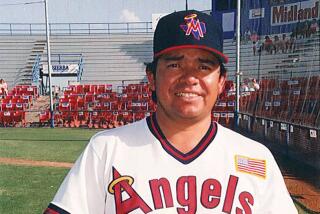Texas Longhorns Tasty, and That’s No Bum Steer
- Share via
A tip of the Stetson to the great state of Texas. It’s her sesquicentennial, the 150th anniversary of the Lone Star State’s independence from Mexico.
This year will undoubtedly see all sorts of celebrations remembering the Alamo, commemorating Davy Crockett, Sam Houston, Jim Bowie and all the legions of legends that helped make Texas a large part of the American heritage.
It’s hard to think of Texas without thinking of cowboys herding longhorn cattle over the long trail north. Much of our Western fashion and folklore grew out of that period between 1866 and 1890 when more than 10 million longhorns were driven from Texas to Kansas and Nebraska to be shipped by rail to market in the Northeast.
Texas longhorns have a history far older than the state, indeed almost as old as post-Columbian America. They were brought here from Spain by Gregorio de Villalobes in 1521. In 1690, the first sizable herd, about 200 head, was driven north to a mission near the Sabine River. Using these “Spanish cattle” as foundation stock, the padres built up large herds to provide meat for their missions throughout the Southwest.
Those early missions and ranches did not always survive, but the longhorns did. They were hard, wiry, able to live on sparse marginal rangeland, eating nothing more than cactus, mesquite and scrub grass. They had a strong natural instinct for self-preservation. Even coyotes and wolves cut a wide path around a herd of longhorns. By the early 1800s, longhorns by the millions were running wild all over Texas--but by the early 1900s, they were bred out of existence and all but extinct. Less than 60 years after the first major cattle drive in 1869, a federal team found fewer than 30 longhorns bearing the breed’s ideal characteristics.
In 1927, Congress appropriated $3,000 to save the longhorn from extinction by establishing a national herd. Three bulls, three steers and 20 cows were gathered up and preserved at the Wichita Refuge in Oklahoma. Thus began the longhorn’s comeback: It is estimated that today there are more than 100,000 head in private herds.
Most modern cattlemen, perhaps, began raising longhorns as a novelty. Longhorns were also raised for film and TV work, as well as for rodeos and parades. In recent years, however, commercial cattlemen have begun again to look to the longhorn as a beef animal.
A few years back, cattlemen began using longhorn bulls on their first-calf heifers. Longhorns produce small calves. Well, it turns out those longhorn-cross cattle do pretty well in the feed lot. One data sheet on a pen of 121 head showed 117 graded USDA Choice, one graded Prime and three graded USDA Good; all with yield grades of three or less except one. You can’t ask for much better in terms of performance than that.
As for flavor, it has been my experience that longhorn beef has a more pronounced beef flavor than what you usually find in the market. Longhorns mature more slowly than most cattle. Some of the big “exotic” breeds reach market weight before they are much more than veal. Longhorns take a few months longer and develop more beefy flavor.
We may have been overlooking one of the best breeds around for producing the kind of beef today’s consumers seem to want: light, lean and flavorful.
More to Read
Sign up for Essential California
The most important California stories and recommendations in your inbox every morning.
You may occasionally receive promotional content from the Los Angeles Times.










